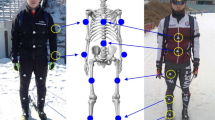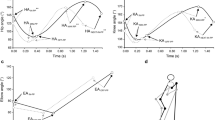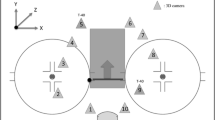Abstract
The purpose was to examine skiing velocities, gear choice (G2–7) and cycle rates during a skating sprint time trial (STT) and their relationships to performance, as well as to examine relationships between aerobic power, body composition and maximal skiing velocity versus STT performance. Nine male elite cross-country skiers performed three tests on snow: (1) Maximum velocity test (V max) performed using G3 skating, (2) V max test performed using double poling (DP) technique and (3) a STT over 1,425 m. Additional measurements of VO2max during roller skiing and body composition using iDXA were made. Differential global navigation satellite system data were used for position and velocity and synchronized with video during STT. The STT encompassed a large velocity range (2.9–12.9 m s−1) and multiple transitions (21–34) between skiing gears. Skiing velocity in the uphill sections was related to gear selection between G2 and G3. STT performance was most strongly correlated to uphill time (r = 0.92, P < 0.05), the percentage use of G2 (r = −0.72, P < 0.05), and DP V max (r = −0.71, P < 0.05). The velocity decrease in the uphills from lap 1 to lap 2 was correlated with VO2max (r = −0.78, P < 0.05). V max in DP and G3 were related to percent of racing time using G3. In conclusion, the sprint skiing performance was mainly related to uphill performance, greater use of the G3 technique, and higher DP and G3 maximum velocities. Additionally, VO2max was related to the ability to maintain racing velocity in the uphills and lean body mass was related to starting velocity and DP maximal speed.





Similar content being viewed by others
References
Abbiss CR, Laursen PB (2008) Describing and understanding pacing strategies during athletic competition. Sports Med 38:239–252
Bentley DJ, Millet GP, Vleck VE, McNaughton LR (2002) Specific aspects of contemporary triathlon: implications for physiological analysis and performance. Sports Med 32:345–359
Bergh U, Forsberg A (2000) Cross-country ski racing. In: Shephard RJ, Åstrand PO (eds) Endurance in Sport. Blackwell Publisher, Oxford, pp 844–856
Bilodeau B, Boulay MR, Roy B (1992) Propulsive and gliding phases in four cross-country skiing techniques. Med Sci Sports Exerc 24:917–925
Bilodeau B, Rundell KW, Roy B, Boulay MR (1996) Kinematics of cross-country ski racing. Med Sci Sports Exerc 28:128–138
Bishop D, Bonetti D, Dawson B (2002) The influence of pacing strategy on VO2 and supramaximal kayak performance. Med Sci Sports Exerc 34:1041–1047
Boulay MR, Rundell KW, King DL (1995) Effect of slope variation and skating technique on velocity in cross-country skiing. Med Sci Sports Exerc 27:281–287
Coutts AJ, Duffield R (2010) Validity and reliability of GPS devices for measuring movement demands of team sports. J Sci Med Sport 13:133–135
de Koning JJ, Bobbert MF, Foster C (1999) Determination of optimal pacing strategy in track cycling with an energy flow model. J Sci Med Sport 2:266–277
Gastin PB (2001) Energy system interaction and relative contribution during maximal exercise. Sports Med 31:725–741
Holmberg H-C (1996) Swedish cross-country skiing. Technique/Methodology classical och free technique. Cewe-forlaget, Farsta
Holmberg H-C, Rosdahl H, Svedenhag J (2007) Lung function, arterial saturation and oxygen uptake in elite cross country skiers: influence of exercise mode. Scand J Med Sci Sports 17:437–444
Jones AM, Wilkerson DP, Vanhatalo A, Burnley M (2007) Influence of pacing strategy on O2 uptake and exercise tolerance. Scand J Med Sci Sports 18:615–626
Kvamme B, Jakobsen B, Hetland S, Smith G (2005) Ski skating technique and physiological responses across slopes and speeds. Eur J Appl Physiol 95:205–212
Larsson P, Henriksson-Larsén K (2008) Body composition and performance in cross-country skiing. Int J Sports Med 29:971–975
Millet GY, Hoffman MD, Candau RB, Clifford PS (1998) Poling forces during roller skiing: effects of technique and speed. Med Sci Sports Exerc 30:1645–1653
Nilsson J, Tveit P, Eikrehagen O (2004) Effects of speed on temporal patterns in classical style and freestyle cross-country skiing. Sports Biomech 3:85–107
Parkinson BW, Spilker JJ (1996) Global positioning system: theory and application. vol 1. American Institute of Aeronautics and Astronautics, Washington
Rundell KW, McCarthy JR (1996) Effect of kinematic variables on performance in women during a crosscountry ski race. Med Sci Sports Exerc 28:1413–1417
Smith GA (1992) Biomechanical analysis of cross-country skiing techniques. Med Sci Sports Exerc 24:1015–1022
Smith G, Kvamme B, Jakobsen V (2009) Effectiveness of ski and pole forces in ski skating. In: Müller E, Lindinger S, Stöggl T (eds) 4th International congress on skiing and science (ICSS). Meyer & Meyer, St. Anton am Arlberg, pp 647–656
Stöggl T, Lindinger S, Müller E (2006) Reliability and validity of test concepts for the cross-country skiing sprint. Med Sci Sports Exerc 38:586–591
Stöggl T, Lindinger S, Müller E (2007) Analysis of a simulated sprint competition in classical cross country skiing. Scand J Med Sci Sports 17:362–372
Stöggl T, Müller E, Lindinger S (2008) Biomechanical comparison of the double-push technique and the conventional skate skiing technique in cross-country sprint skiing. J Sports Sci 26:1225–1233
Stöggl T, Enqvist J, Müller E, Holmberg H-C (2010) Relationships between body composition, body dimensions, and peak speed in cross-country sprint skiing. J Sports Sci 28:161–169
Takac F, Hilker C, Kotthoff H, Richter B (2005) Combining measurements from multiple global navigation satellite systems for RTK applications. International Symposium on GPS/GNSS, Hong Kong, p 7
Terrier P, Schutz Y (2003) Variability of gait patterns during unconstrained walking assessed by satellite positioning (GPS). Eur J Appl Physiol 90:554–561
Terrier P, Ladetto Q, Merminod B, Schutz Y (2000) High-precision satellite positioning system as a new tool to study the biomechanics of human locomotion. J Biomech 33:1717–1722
Terrier P, Turner V, Schutz Y (2005) GPS analysis of human locomotion: further evidence for long-range correlations in stride-to-stride fluctuations of gait parameters. Hum Mov Sci 24:97–115
Acknowledgments
The authors thank the athletes for their participation, enthusiasm and cooperation in this study. This study was supported by the Swedish Olympic Committee.
Conflict of interest statement
None.
Author information
Authors and Affiliations
Corresponding author
Additional information
Communicated by Jean-René Lacour.
Rights and permissions
About this article
Cite this article
Andersson, E., Supej, M., Sandbakk, Ø. et al. Analysis of sprint cross-country skiing using a differential global navigation satellite system. Eur J Appl Physiol 110, 585–595 (2010). https://doi.org/10.1007/s00421-010-1535-2
Accepted:
Published:
Issue Date:
DOI: https://doi.org/10.1007/s00421-010-1535-2




